
PREV ARTICLE
NEXT ARTICLE
FULL ISSUE
PREV FULL ISSUE
CLASSICAL NUMISMATIC GROUP TRITON XXII SALEHere is the press release for Classical Numismatic Group's January NYINC sale, Triton XXII. Some beautiful classic coins. -Editor Features Multiple Collections & Individual Rarities Classical Numismatic Group, LLC of Lancaster, Pennsylvania and London, England is proud to present Triton XXII, a Public, Internet, and Mail Bid Sale to be held in conjunction with the 47th Annual New York International Numismatic Convention (NYINC) on January 8-9, 2019. The 2019 NYINC will be held at the Grand Hyatt Hotel, located at 109 East 42 nd Street, New York, NY 10022, between Park and Lexington Avenues. Triton XXII features 1456 lots of Greek, Celtic, Oriental Greek, Central Asian, Roman Provincial, Roman Republican & Imperatorial, and Roman Imperial coinage. Additionally, there are featured selections of Byzantine, Early Medieval, Islamic, World, and British coinage, as well as a nice selection of large lots. The pre-sale estimate total for Triton XXII is just shy of $8 million. Triton XXII is highlighted by a number of collections and individual rarities, which make up the majority of coins on offer:
Lot viewing for Triton XXII will begin on Sunday, January 6th , from 1PM until 7PM in the Broadway Room, located on the Conference Level (CC floor) of the Grand Hyatt Hotel.
The complete lot-viewing schedule for Triton XXII is: Auction lots will also be available for viewing at the Pennsylvania offices of CNG from Wednesday, December 5th , 2018 until Friday, December 21st , 2018 by appointment only. Please note that CNG’s office hours will be limited during the holiday season. The auction sessions for Triton XXII will be held in the Empire State Ballroom I, located on the Ballroom Level (B floor) of the Grand Hyatt Hotel. Triton XXII will be conducted over four sessions with the morning sessions beginning promptly at 9:30 AM on Tuesday, January 8th , and Wednesday, January 9th , 2019, and the afternoon sessions will start at 2 PM on the same days. In addition, there will be an online, Internet-only, Session 5 for Triton XXII, which CNG will be conducting as our Electronic Auction 436, and will open for bidding on January 2nd , 2019. E-Sale 436 will feature over 1,000 lots, with a closing date of Wednesday, January 23 rd , 2019, and will include coins from some of the same collections listed above. Printed catalogs for Triton XXII are now available. To order a catalog, please visit www.cngcoins.com. The catalog is $75 to North American addresses, and $100 to the rest of the world. Payment may be made by U.S. $ check or Visa/MasterCard. Catalogues have already been mailed to customers on CNG’s active mailing list. CNG is currently accepting consignments for its next Mail Bid and Internet auction, CNG 111, scheduled for May 8th , 2019. The consignment deadline is Friday, January 25 th , 2019. For further details and any additional information, please contact CNG, LLC at: Classical Numismatic Group, LLC P.O. Box 479 Lancaster, PA 17608-0479 Telephone: (717) 390-9194 Fax: (717) 390-9978 Email: cng@cngcoins.com About the NYINC: Just a few of the individual highlights from Triton XXII are:  Lot 18–LUCANIA, Metapontion. Circa 540-510 BC. AR Nomos (28.5mm, 6.89 g, 12h). Ear of barley with seven grains; META down left field, grasshopper upward to right / Incuse ear of barley with seven grains; outline of dolphin upward to left. Noe Class V, 100 (same dies); HN Italy 1472; SNG ANS 206 (same dies); Basel 130 (same dies); Gillet 132 (this coin); Kraay & Hirmer 229 (same dies). Near EF, toned, die breaks on reverse (diagnostic for die). Estimated at $20,000 From the Gasvoda Collection. Ex Numismatica Ars Classica 92 (23 May 2016), lot 88; A. D. Moretti Collection; Numismatica Ars Classica 18 (29 March 2000), lot 22; Numismatica Ars Classica 9 (16 April 1996), lot 57; Leu 42 (12 May 1987), lot 46; Charles Gillet Collection. From the consignor: The most interesting type of the incuse coinage of Metapontum certainly must be the issues that include the locust (or grasshopper) design detail, as here. There are a number of variations. Here it is paired with a dolphin in outline. The locust would have been a serious threat to the agricultural community and likely the dolphin relates to Apollo who would have been seen as the God who eliminated a plague of these insects in the year this coin was struck. 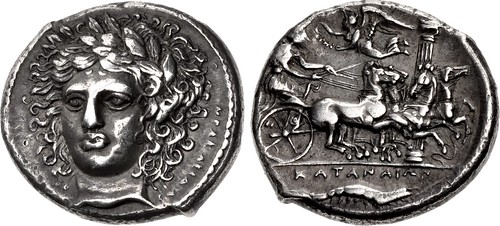 Lot 120–SICILY, Katane. Circa 405-403/2 BC. AR Tetradrachm (27mm, 17.18 g, 12h). Obverse die signed by Herakleidas. Head of Apollo facing slightly left, wearing laurel wreath; HPAK?EI?AS to right / Charioteer, holding kentron in right hand, reins in both, driving fast quadriga right; above, Nike flying left, crowning charioteer with open laurel wreath held in both hands; Ionic column in right background; in exergue, KATANAION above crawfish right. Mirone 61 (same dies as illustration); HGC 2, 576; SNG ANS 1257 (same rev. die); BMC 33 (same dies); Gillet 400 = Jameson 547 (this coin); cf. Gulbenkian 192/193 (for obv./rev. dies); Hirsch 339 (same dies). Good VF, lovely old collection tone, a few marks under tone. Very Rare. A classic piece from the era of the Sicilian masters with a delightful portrait of Apollo in superb style. Estimated at $100,000 From the Gasvoda Collection. Ex America Collection (Numismatica Ars Classica 96, 6 October 2016), lot 1014; New York Sale XX (7 January 2009), lot 74; de Guermantes Collection (Leu 86, 5 May 2003), lot 269; Leu 18 (5 May 1977), lot 59; Charles Gillet Collection; Robert Jameson Collection; Gustave Durulfé Collection (not in Rollin et Feuardent sale); Billoin Collection (Rollin et Feuardent, 22 March 1886), lot 184 (not illustrated, but cited by Jameson). Founded about 730/29 BC by the colonists from the neighboring Chalkidian colony of Naxos, the city of Katane was located on the eastern coast of Sicily on the fertile Katanian plain near the southern limits of the lava flows from Mt. Aitna. Like its neighbor to the north, Leontini, the city prospered from its exploitation of the fertile plain for the production of barley. When it began striking coinage in the mid-fifth century BC, Katane included on its issues the local river, Amenanos, which was responsible for the fertility of the soil. Like other contemporary Greek riverine depictions, the river-god is portrayed as a human-headed bull (see lot 117 above). Later issues, however, perhaps influenced by other regional coinages, give the river-god a more youthful and androgynous appearance. Katane's prosperity attracted the attention of its immediate and more-powerful neighbor Syracuse. In 476 BC, Hieron I expelled the population from Katane, driving them north to Leontini. In turn, Katane was "refounded" with a new body of colonists consisting of Syracusan citizens and Dorian mercenaries. Renamed Aitna, it issued a short-lived and very rare coinage, featuring the head of Silenos on the obverse and either Zeus or his thunderbolt on the reverse. This Syracusan overlordship was short-lived, and in 461 BC the original inhabitants of Katane were restored to the city, while the inhabitants of Aitna were withdrawn to the fortress of Inessa, which they renamed Aitna. To commemorate the reinstatement of its original inhabitants, Katane struck a remarkable series of tetradrachms featuring the river-god Amenanos on the obverse and Nike holding a wreath, diadem, or fillet on the reverse. Several different adjuncts, such as a Silenos or a ketos are included on the obverse as well. Such additions may be evidence of regional influences resulting from Katane's recent history. Such is the case after about 460 BC when this issue was replaced by one featuring a quadriga similar to that of Syracuse, but without the additional Nike, on the obverse and the laureate head of Apollo, similar to that of Leontini, on the reverse (see lot 118 above). Katane continued to prosper until the late 5th century BC, when the city entered a period when it became continually embroiled in conflicts between other states. In 415 BC, Katane was attacked and captured by Athens, which used the city as the base of operations for the first year of the famous Sicilian Expedition. Later, in 403 BC, Katane fell to Dionysios I of Syracuse, who, like Hieron I before him, re-founded the city, this time with Campanian mercenaries. In the period leading up to this conflict with Syracuse, the coinage of Katane underwent another transformation. By the late 5th century BC, the numismatic art of Sicily had achieved an unparalleled degree of quality in the Greek world. This was due in large part to the great masters whose signatures are boldly displayed on their minute canvasses: Choirion, Euainetos, Eumenos, Exakestidas, Kimon, and others. Most of these artists are known from their work in the Syracusan series, but a few also created masterful works of art at other cities as well. One of these, Herakleidas, created a magnificent facing head type that is a standout among the famed Katanean issues. Certainly influenced by the Kimonean facing-head portraits of Arethusa on tetradrachms at Syracuse, the subject here was the god Apollo, whose profile portrait was featured on the reverse of earlier issues of Katane. Here, the god's portrait has become the prominent feature of the coin, moving to the obverse and appearing in a nearly frontal aspect. One may sense Herakleidas' attempt to portray Apollo in a naturalistic form, retaining through his countenance an attitude of an other-worldly god, while introducing a delicacy that conveys the thought of a living being. The hair falls in individual locks reminiscent of Arethusa of Syracuse, but rather than radiating outward, as if in an aquatic environment, they are depicted in a downward splayed fashion, evoking the picture of a woodland entity whose natural appearance would retain a hint of the wild. His laurel wreath is likewise splayed, as though placed upon his head directly from the laurel bush, without any thought of molding or preparation. In contrast, his wide eyes gaze outward with an obvious power that belies his heavenly nature. The viewer has the impression that he is looking into the face of a living god. Herakleidas' work represented the high point of numismatic artistry at Katane, a period that was cut short by the conquest of the city by Dionysios I. In the early 4th century, Katane's close relationship with Syracuse made the city a target for the Carthaginians. In 396 BC, they captured Katane, and held it for about 50 years, until it was finally liberated by Timoleon in the 340s BC. When Pyrrhos landed in Sicily in 278 BC, Katane was the first Sicilian city to welcome him, opening its gates and receiving him with great pomp (Diod. 19. 110; 22. 8). By the time of the First Punic War, however, Katane submitted itself to Rome, a friendly arrangement that allowed the city to regain much of its former prosperity. Katane was ravaged a final time, by Sextus Pompey, during the Roman Civil War, but its refoundation as a colony under Augustus resulted in a renewed prosperity as a provincial town. 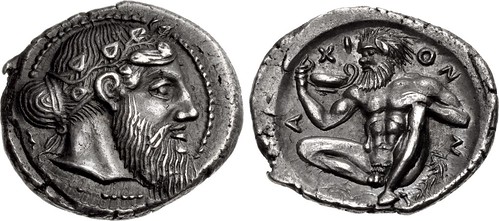 Lot 130–SICILY, Naxos. Circa 461-430 BC. AR Drachm (19mm, 4.32 g, 7h). Bearded head of Dionysos right, wearing tainia decorated with an ivy branch / Silenos, nude and bearded, squatting half-left, holding kantharos in right hand and resting his left on his knee, tail behind; N-A-XI-ON around; all within shallow concave circular incuse. Cahn 55.1 (V40/R46) = Gillet 484 = Sartiges 110 = H. Dannenberg, Grundzüge der Munzkunde (1912), pl. I, 7 = J. Friedländer, “Die Erwerbungen des Koniglichen Miinzkabinets vom 1. Januar 1877 bis 31. März 1878.” in ZfN 6 (1879), p. 10 and pl. I (this coin); HGC 2, 990; SNG Lloyd 1151 = Weber 1467; Basel 385; SNG Lockett 841 = Pozzi 508; Jameson 674; de Luynes 1063; McClean 2467; Rizzo pl. XXVIII, 13 (all from the same dies). Superb EF, lovely deep cabinet tone. Among the finest examples of the type, with a choice pedigree. Estimated at $150,000 From the Gasvoda Collection. Ex Triton XIX (5 January 2016), lot 44; Leu 81 (16 May 2001), lot 89; Charles Gillet Collection (1972), 484; Vicomte de Sartiges Collection, 110; Duplicates from the Berlin Königliches Münzkabinett (J. Hirsch XXVI, 24 May 1910), lot 81 (acquired by the museum c. 1874); Arthur Löbbecke Collection. In the Hirsch sale of the Berlin duplicates, this coin received a rare lengthy note: Euböische Drachme von wundervollem Uebergangsstil. Cabinettstück ersten Ranges. Avers und Revers einzigartig im Raume stehend. Pracht-exemplar, wohl das schönste der bekannten Exemplare und deshalb von grösster Seltenheit. [Euboean drachm of wonderful transitional style. Choice example of the first order. Obverse and reverse superbly well centered and struck. Magnificent example, probably the finest of the known specimens and therefore of the utmost rarity.] On the day of the sale, the coin hammered at 2225 DM, an exceptional amount for a drachm, and the same price that the Berlin Museum’s Naxos tetradrachm of Cahn 54 type realized in the same sale. Located on the eastern shore of Sicily in the shadow of Mt. Aitna, Naxos was the oldest of the Greek colonies on the island, founded in 735 BC by colonists from Chalkis in Euboia and Ionia. According to Thucydides (1.100), Naxos established its own colony by founding Leontini in 730 BC, which was soon followed by the foundation of a second colony, Aitna, later known as Katane. Taking advantage of the fertility of the surrounding volcanic soil of Mt. Aitna, Naxos developed an economy of viticulture, and along with Leontini and Katane became very prosperous. This wealth attracted the attention of Syracuse, which subjugated Naxos in 476 BC, removing its citizens along with those of Katane to Leontini. Upon the death of Hieron in 461 BC, the Naxians were reinstated to their original city, and formed a close alliance with Leontini and Katane. During the first Athenian Expedition in 427 BC, Naxos actively provided support to the Athenians, who had sent a large fleet to support the allies against Syracuse. In 409 BC, Naxos sided with Syracuse against the Carthaginian threat to Sicily, but in 403 BC, the tyrant Dionysios of Syracuse turned against the Naxians, destroying the city and selling the women and children into slavery. The present issue is composed of multiple denominations in silver, and is dated by Cahn to the first few decades after the refoundation of the city in 461 BC. Some theorize that it was struck upon the refoundation as a celebratory issue, but one wonders whether the city had the resources for such a coinage so soon. It could also have been struck somewhat later, after the city had prospered from its trade ties to Kamarina and Leontini, and could afford the requisite silver for such a large output. The types found on the drachms are the same as that on the famed tetradrachms (Cahn 54), and the styles of both are so close that it is likely they were engraved by the same hand. The obverse features Dionysos, the god of the vine. The reverse is also an allusion to wine and the Dionysiac cult, featuring the satyr Silenos. Half-man, half-goat followers of Dionysos, these satyrs were often depicted in an ithyphallic state as they pursued the god’s female attendants, the maenads. Silenos was the oldest, wisest, and most drunken of the satyrs. According to Euripides’ only surviving satyr-play, the Cyclops, Silenos had been forced to attend to Polyphemos, who dwelled in the region of Mt. Aitna, hence providing another reason for Silenos’ appearance on this coin of Naxos. 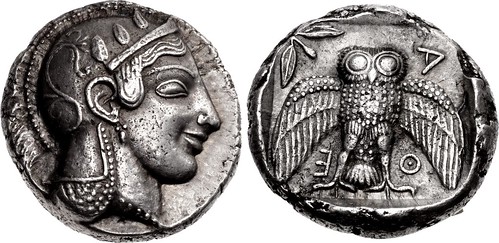 Lot 211–ATTICA, Athens. Circa 469/5-460 BC. AR Dekadrachm (31.5mm, 43.38 g, 3h). Head of Athena right, with frontal eye, wearing single-pendant earring, necklace with pendants, and crested Attic helmet decorated with three olive leaves over the visor and a spiral palmette on the bowl / Owl standing facing, wings spread; olive sprig and crescent to upper left, A-T-E clockwise around from upper right; all within incuse square. Fischer-Bossert, Athenian 24a (O14/R23’) = Stannard & Fischer-Bossert pp. 8–18 (this coin); Starr Group II.C (unlisted dies); Seltman 445–52; HGC 4, 1585; SNG Berry 641; BMC 40 = ACGC 188; Gulbenkian 515 = Jameson 2080; Hirsch 1272; Kraay & Hirmer 357–8; Zhuyuetang 31 (same obv. die). EF, attractive deep gray tone, with iridescence around the devices. Superb metal quality for issue, and perfectly centered strike. Estimated at $500,000 From the Spina Collection. Ex North American Collection of Numismatic Masterpieces (Triton X, 9 January 2007), lot 230. The present coin represents a splendid example of this magnificent ancient work of art, with a surface quality far exceeding that of the specimens offered over the past several years. It exhibits clear flow lines, very sharp detail junctures, and a crispness often lacking in such large module ancient coins. Additionally, the aesthetic quality of the reverse is exceptional, an extremely powerful design with a well-defined and expressive owl in full glory. The historical context of the Athenian dekadrachms, as well as concomitant tetradrachms and didrachms of the same class, has been the matter of extended debate. Much of the early confusion stems from a passage in Herodotos, who said that Athens paid ten drachms to each of its citizens for surpluses from the Laurion mines (7.144.1). Although this passage appeared to provide easy historical evidence for the dekadrachm issue, not every scholar was convinced. It was Ernest Beulé who first raised the chronological question of the issue, and from whom all subsequent research stemmed. Taken in context, the passage in Herodotos would place such an issue shortly after the victory at Marathon in 490 BC, a date that was accepted for the dekadrachm issue by prominent early numismatists, Babelon (Traité II, col. 769-770) and Head (HN, pp. 370-371), but which subsequent scholarship has shown to be far too early. Although Gardner retained the 490 BC date of issue in keeping with Babelon (A History of Ancient Coinage, 700-300 BC, p. 162), he added to the discussion by recognizing that the Athenian dekadrachms were contemporary with those of Syracuse, which he identified with the Demareteia mentioned in the ancient sources and dated to the immediate period following the battle of Himera in 480 BC. Seltman, in his major work on the pre-Persian coinage of Athens, rejected Babelon’s conclusions. Yet, he also failed to put credence in the views of Gardner and subsequently placed the issue far too early, in the later 480s BC. Almost immediately, this view came under fire. Robinson saw Salamis as the occasion for issue (NC [1924], pp. 338-340), and Regling, in his revised edition of Sallet’s Die antiken Münzen, viewed the combined victories of Salamis and Plataiai as the occasion. It was Kraay (NC [1956], p. 55; ACGC, pp. 66-68) who, paying attention to the evidence of the hoards, noted that Seltman’s chronology was far too early; yet, he failed to convince his critics. Starr, whose own study of Athenian coinage also relied on the evidence of the hoards, confirmed some of what Kraay had argued, and suggested that the occasion for the issue of the dekadrachms was the battle near the river Eurymedon (circa 469/5 BC). The subsequent discovery of the Asyut Hoard (IGCH 1644) in 1968/9 and the Elmali Hoard (CH VIII, 48) in 1984, confirmed a mid-460s BC date. Various interpretations of the dekadrachms’ purpose have also been proposed. Although Fischer-Bossert suggests that the size of the issue indicates an economic, rather that ceremonial purpose, Head, much of whose work had formed the basis of dekadrachm scholarship, thought they were special, ceremonial issues struck at various times for "the personal gratification of Tyrants or Kings", and were not part of the actual currency. As seen above, Starr's survey of the Athenian coinage, and his confirmation of Kraay’s earlier conclusions, rejected this earlier conception. It seems clear that such an exceptional and compact issue must have served some special function. Recent scholars have focused on two key historical events during this period that could have produced sizable quantities of silver for this series: the battle of the Eurymedon River in 467 BC, where the resulting captured Persian booty was enormous and was attested to have been distributed (Plutarch, Vit. Cim. 13.6-8), and the capture of Thasos and its mines in 463/2 BC, where the plunder is assumed to have been substantial (Plutarch, op. cit. 14.2). The dekadrachms stand apart from the typical Athenian coinage not only by their massive size, but the transformation of the reverse type from an owl in profile to one facing the viewer. One cannot fail to notice the power in such a portrayal, which clearly is a representation of the growing Athenian military might that produced the victory over the Persians at the Eurymedon River and the later capture of the bountiful Thasian mines. 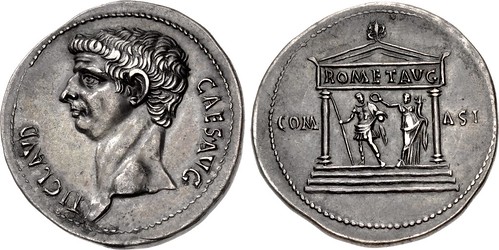 Lot 1014–Claudius. AD 41-54. AR Cistophorus (28mm, 11.47 g, 6h). Ephesus mint. Struck AD 41-42. TI CLAVD CAES · AVG, bare head left / COM ASI across field, distyle temple of Roma and Augustus, enclosing standing facing figures of Claudius, holding scepter, being crowned by Fortuna, holding cornucopia; ROM ET AVG on entablature. RIC I 120 (Pergamum); RPC I 2221; RSC 3; BMCRE 228; BN 304-6. Choice EF, deep cabinet toning. Exceptional portrait coin. Estimated at $20,000 Ex Hess-Divo 307 (7 June 2007), lot 1567; Sternberg XIX (18 November 1987), lot 549. 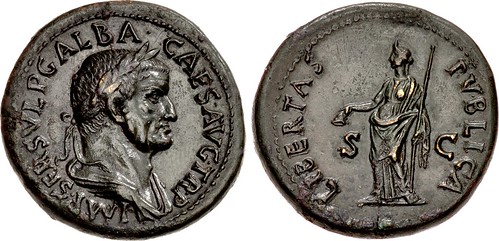 Lot 1036–Galba. AD 68-69. Æ Sestertius (36mm, 26.89 g, 6h). Rome mint. Struck circa August–October AD 68. IMP · SER · SVLP GALBA · CAES · AVG · TR · P, laureate and draped bust right / LIBERTAS PVBLICA, S C across field, Libertas standing left, holding pileus and vindicta. RIC I 309; ACG dies A116/– (unlisted rev. die): BMCRE 71; BN 147–50. EF, wonderful dark green patina. Bold portrait. Estimated at $30,000 Ex Friend of the Romans Collection (Münzen und Medaillen AG 92, 22 November 2002), lot 46; James Fox Collection (Classical Numismatic Group 40, with Numismatica Ars Classica, 4 December 1996), lot 1408; Beverly Hills Sale (Numismatic Fine Arts XII, 23 March 1983), lot 206; Leu 18 (5 May 1977), lot 304. Though reigning scarcely seven months, Servius Sulpicius Galba has the honor of inspiring Rome’s portrait artists to reach heights never again equaled or surpassed. Achieving the throne at age 70, Galba was a wizened Roman aristocrat whose sagging, craggy countenance could not have been more different than that of his predecessor, the bloated and dissolute Nero. Indeed, Galba seems to have deliberately promoted himself as a steely martinet who would restore Rome to proper Republican austerity. His coinage pairs his aged, scowling portrait with reverses touting traditional Roman virtues, here depicting Libertas, a concept that embodies both freedom and responsibility. Rome’s mint masters rose brilliantly to the challenge, producing astoundingly lifelike and sculptural portraits such as the present example. But Galba’s austerity program proved to be a major miscalculation, as Rome was not yet ready for such bitter medicine. 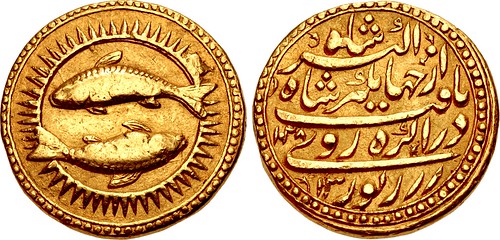 Lot 1259–INDIA, Mughal Empire. Nur al-Din Muhammad Jahangir. AH 1014-1037 / AD 1605-1627. AV Mohur (22mm, 10.83 g, 1 or 7h). Zodiac Type, Class A. Agra mint. Dated [Isfandarmuz] AH 1028 (19 December AD 1618-7 December AD 1619) and RY 13 (15/24 October AD 1617 – 14/23 October AD 1618). Constellation of Mahik/Matsya (Pisces the Fish): tête-bêche pair of carp; radiate sun behind / zar zewar dar Agra ruye yaft az Jahangir Shah Akbar Shah (Received ornament on gold at Agra from Jahangir Shah [son of] Akbar Shah) in Persian verse; RY and AH dates to left. Liddle Type G-111 (same dies as illustration); BM 358; Wright 582; Hull 1407-8; KM 180.20; Friedberg 773. VF, lightly toned, traces of deposits in devices, a few minor field marks. Estimated at $100,000 Previously to this, the rule of the coinage was that on the face of the metal they stamped my name, and on the reverse the name of the place and the year of the reign. At this time it entered my mind that in place of the month they should substitute the figure of the constellation which belonged to that month...in each month that was struck, the figure of the constellation was to be on one face, as if the sun was emerging from it. The Memoirs of Jahangir [Tuzk-e Jahangiri] (Entry for 20 March 1619) In the 29th year of his reign, the Mughal emperor Akbar (1556-1605) established the Din-e Ilahi (literally faith of God), a syncretic belief system that incorporated elements of the different religious beliefs in his empire. Immediately thereafter, Akbar began counting his reign in accordance with the tenets this new belief system. Known as the Ilahi Era, dating was now based on a solar, rather than lunar, calendar with the year divided into twelve Ilahi months. Akbar’s early successors continued to employ this dating system. Jahangir (1605-1628), Akbar’s son and immediate successor, used the Ilahi Era to great artistic effect by issuing two series of mohurs that incorporated Ilahi Era elements. The earliest series, known as the portrait series, since the coins show the emperor on the obverse, all show the constellation Leo superimposed over the sun – a reference to Jahangir’s birth in August. This series was struck within a three-year span early in Jahangir’s reign and are quite rare. The second series, known as the zodiac series, since each of the twelve constellations of the Zodiac is represented on the reverse, was a much larger series. Struck both in gold and silver, the zodiac series was issued from several mints (with Agra being the primary), and like the previous series, minted over three or four years. Since the Ilahi months were solar months and corresponded with the solar ecliptic (an imaginary line in the sky that marks the annual path of the sun), each month was represented by an appropriate sign of the Zodiac, recording its particular month of issue. Because many of these coins had been recalled and melted by Jahangir’s successor, Shah Jahan, original strikes are very rare. Collector restrikes were periodically issued over the following century, and though they are more often encountered than the originals, are relatively rare themselves. Numismatists have divided the portrait and zodiac series mohurs into four classes: Class A: Undisputed original strikes, characterized by deep relief, somewhat uneven flans, and rounded calligraphy. Class B: Possibly original strikes, but more likely minted in the first decade or two following Jahangir’s death. The relief is shallower, of a more uniform appearance, and the calligraphy is more square. Class C: Mohurs of Class A or B that have had the zodiac type removed and re-engraved. Class D: Later imitations and forgeries. 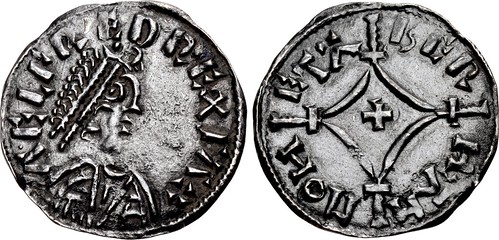 Lot 1368–ANGLO-SAXON, Kings of Wessex. Alfred the Great. 871-899. AR Penny (19mm, 1.30 g, 12h). Cross-and-Lozenge type (BMC v). Uncertain mint; Beorheah(?), moneyer. Struck circa 877-880s. ?ELFRED REX S?X, diademed bust right / BER HAH MOH ET?, cross pattée within lozenge over long beaded cross; crossbars at lozenge ends. Blackburn & Keynes Canterbury B style (moneyer unrecorded); SCBI –; BMC –; North 629; SCBC 1058. Near EF, darkly toned. Unrecorded moneyer for issue. Extremely rare. Estimated at $20,000 Ex Classical Numismatic Group 87 (18 May 2011), lot 2074. Our understanding of the cross and lozenge coinage of Alfred the Great and his contemporary Ceolwulf II of Mercia has been transformed by the discovery of the Wattlington Hoard in 2015. This extremely important hoard of some 200 coins, jewellery and hack silver was acquired by the Ashmolean Museum after a major fund raising campaign. The cross and lozenge coinage is now firmly recognized as a joint issue of the kings of Wessex and Mercia acting in unison under extraordinary circumstances as their territories were ravaged by marauding Viking armies. Though Mercia was unable to withstand the onslaught Alfred held firm and turned the tide against the foreign invaders, laying the foundations for a new, united kingdom of England in the struggle.  Lot 1406–PLANTAGENET (ANGLO-GALLIC). Edward the Black Prince. As Prince of Aquitaine, 1362-1372. AV Hardi d'or – Guyennois (27mm, 4.01 g, 6h). Bordeaux mint. Struck circa 1368–1371/2. + ЄD’ · PO · GnS · RЄGIS · ΛnGLIЄ · PnS · ΛQITΛNIЄ (rosette stops), half-length figure of Edward facing, wearing plain diadem, holding sword in left hand and pointing at it with his right, within tressure of arches / + : ΛVXILIVm · mЄVm · Λ · DOmInO · B : (rosette stops within), cross quernée, with quatrefoil at center; leopards and lis alternating in angles; all within tressure of arches. AGC 178, 3/a; Elias 161; Elias Collection 250 var. (obv. legend); Schneider 60 var. (same); Duplessy, Féodales 1122; Poey d'Avant 2940; SCBC 8128. In NGC encapsulation, 4833043-001, graded MS 64. Superb portrait. Rare. Estimated at $15,000 Humphrey Sutherland praised the restraint and foresight of the unknown master who designed this type, who "in age when sumptuous decoration of all redundant space was the normal fashion, was content - and dared - to leave the field totally devoid of ornament within its encircling tressure. By this means he concentrated upon this larger and more personal portrait, so lifelike in its almost voluptuous forms, an emphasis which the Italian artists themselves were only just beginning to estimate and enjoy.” Art In Coinage, p. 154. THE BOOK BAZARREWayne Homren, Editor The Numismatic Bibliomania Society is a non-profit organization promoting numismatic literature. See our web site at coinbooks.org. To submit items for publication in The E-Sylum, write to the Editor at this address: whomren@gmail.com To subscribe go to: https://my.binhost.com/lists/listinfo/esylum All Rights Reserved. NBS Home Page Contact the NBS webmaster 
|